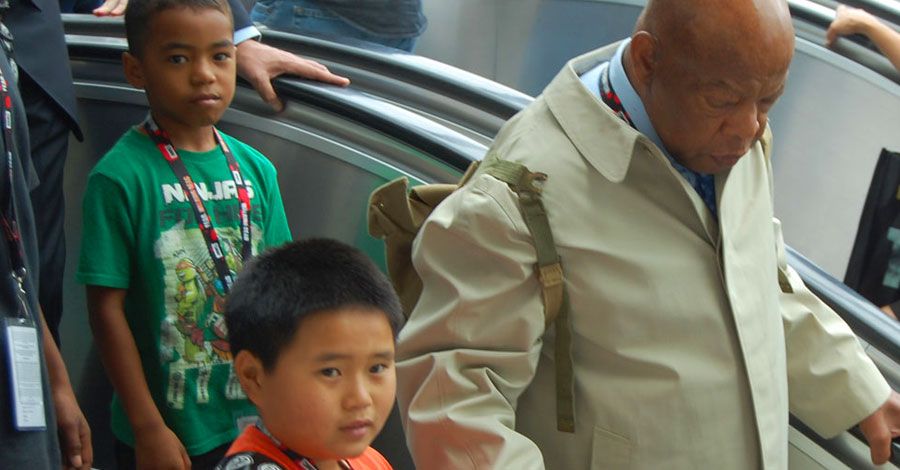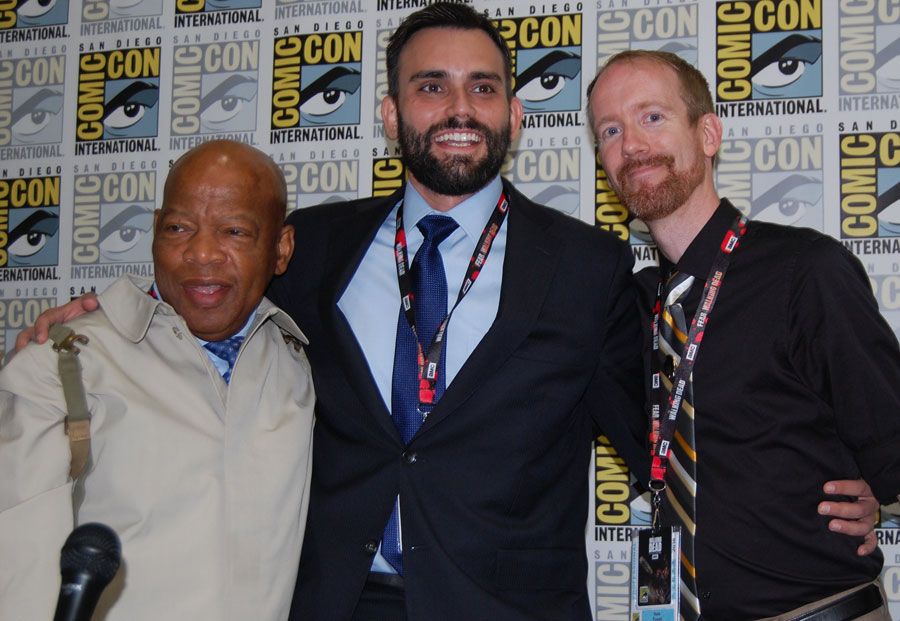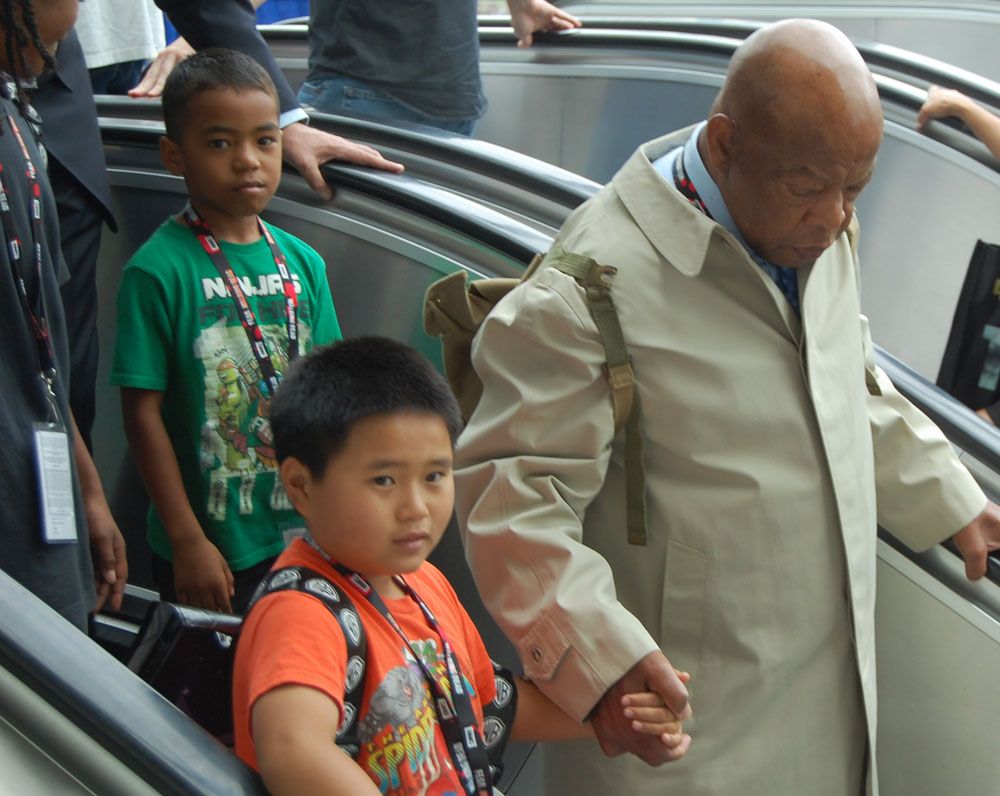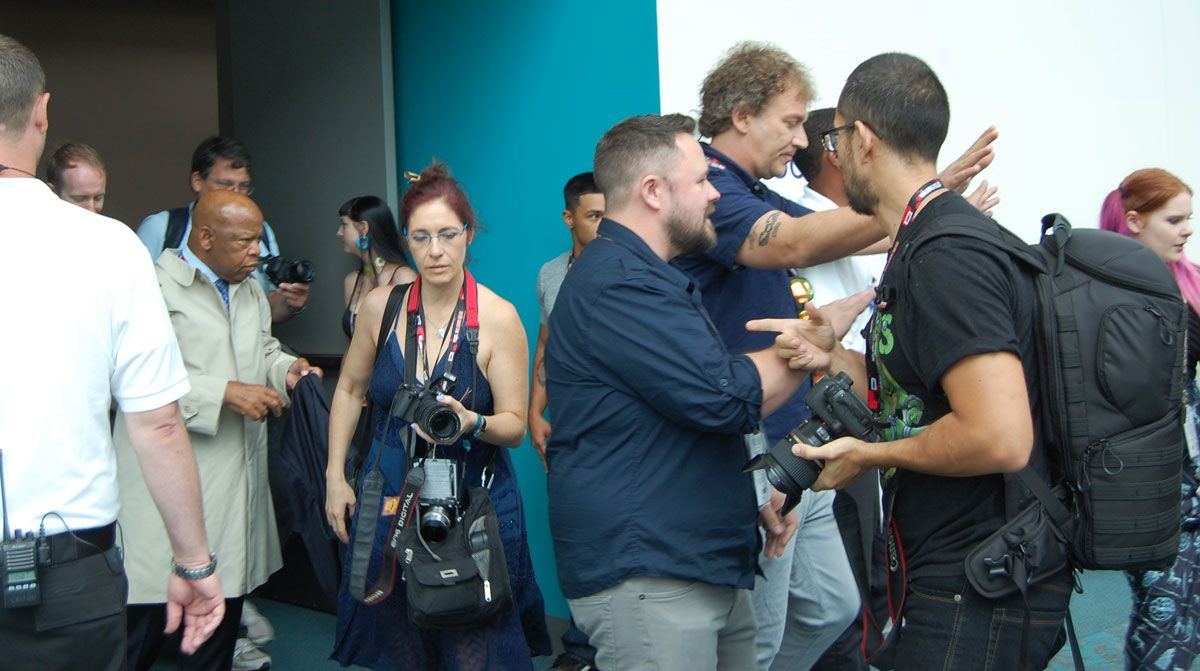Congressman John Lewis cosplayed as his younger self for his panel at Comic-Con International in San Diego. Wearing a trench coat and backpack, the Civil Rights leader looked just as he did when he set out on the march from Selma to Montgomery, Alabama, in 1965, to advocate for the cause of voting rights for African Americans.
"I was wearing a backpack before it became fashionable to wear a backpack," he told a room filled to capacity with fans, schoolchildren and reporters. "I was wearing a trench coat similar to this trench coat. I had two books -- today I have three books [the "March" trilogy] -- and one apple and one orange in that backpack. I wanted to have something to eat. And toothpaste and toothbrush. I was going to be arrested, going to jail, and I wanted to be able to brush my teeth."
RELATED: Top Shelf Gives "March: Book One" Oversized Hardcover Treatment
Book three of "March," co-written by Lewis and Andrew Aydin and illustrated by Nate Powell, tells the story of that march and the events that led up to it, starting with the bombing of a church in Birmingham, Alabama that killed four girls. The second volume had just won an Eisner Award for Best Reality-Based Work the night before, and as he did last year, Lewis concluded the panel by leading a procession of children to the convention floor. But first, he testified to his experiences in cadences that were reminiscent of a preacher -- his first choice of a career -- interrupted frequently by bursts of applause.
Lewis grew up in Troy, Alabama, where his father, a former sharecropper, owned a small farm. When he questioned the "white" and "colored" signs he saw everywhere, his parents told him, "That's the way it is. Don't get in the way. Don't get in trouble."
But he did. "In 1955, 15 years old, in the tenth grade, I heard of Rosa Parks, I heard the words of Martin Luther King, Jr., and I was inspired to get in trouble, to get in the way, and ever since then I have been getting in good trouble -- necessary trouble. So 'March' is written to inspire a new generation of young people to stand up, to speak up, to speak out, and get in good trouble, necessary trouble."
Edwards' trouble, of course, included leading the 1965 voting rights march that was supposed to go from Selma to Montgomery.
"We got to the highest point on the Edmund Pettus bridge, looking down below," Lewis recalled. "We saw a sea of blue -- Alabama state troopers. One young man walking beside me, by the name of Jose Williams, from Dr. King's organization, said to me, as we walked across an Alabama river, 'John, can you swim?' I said, 'No. Jose, can you swim?' He said, 'Yes, a little.' I said, 'There's too much water in this river. We cannot jump. We must go forward.' We came to the highest point on the Edmund Pettus Bridge, and we saw a sea of blue, Alabama state troopers, and behind the state troopers, members of the sheriff's posse that had been deputized to stop the march. We came within hearing distance of the state troopers. A man said, 'I'm Major John Cloud of the Alabama state troopers. This is an unlawful march. It will not be allowed to continue. I give you three minutes to disperse and return to your home or your church.' Jose Williams said, 'Major, give us a moment to kneel and pray.' The major said, 'Troopers, advance!' I said, 'Major, may I have a word?' He said, 'There will be no word.'
"We saw these men putting on their gas masks. They came toward us, beating us with nightsticks, bullwhips, trampling us with horses, releasing the tear gas. We were the first ones to be hit, knocked down on that bridge. My legs went out from under me. I thought I saw death. I thought I was going to die. Fifty-one years later, I don't know how I made it back across that bridge." In fact, a group of sympathizers took him to a nearby church and then to the hospital. Shortly thereafter the marchers went to court, and two weeks later, after a Federal judge declared they were protected by the Constitution, they successfully marched from Selma to Montgomery.
"The story of 'March' is us saying that we must never ever give up or give in," Lewis said. "That we must keep your faith, and keep our eyes on the prize. That we must use the way of peace, the way of love, the way of nonviolence, to overcome hate. That we must do what we can to redeem the soul of America. If someone had told me then, while we were marching, being beaten, being jailed, that I would live to see an African American become president of the United States, I would say, 'You don't know what you are talking about. You must be dreaming.' But it happened."
Reminding the audience that the struggle of "March" is not yet over, Aydin spoke of growing a beard as a reaction to the "awful things" Republican presidential nominee Donald Trump has said about Muslims. "My father was a Muslim immigrant," Aydin said. "I work on Capitol Hill, and I work with people who think it is OK for him to say what he is saying. My mother never wanted me to grow facial hair... She didn't want me to look Muslim. When Donald Trump started saying all of that mess, I started growing a beard. My mother hated it. Because I want the people on Capitol Hill, the people who are the Congressman's colleagues, the people who are my colleagues, and they ask, 'Hey, why did you grow a beard?' I want them to know, [it's] because of their bigotry, because of what they are doing to our society. Nonviolence is not a tool or a tactic. It is a way for all of us to live our lives. I hope in some small way that I am doing that. I think 'March' is a nonviolent act."
At the conclusion of the panel, Lewis and the publisher's staff gathered a group of children for the procession to the exhibit area. As soon as the group left the panel room, they were surrounded by a crowd of reporters and photographers, who had to be held back by the publisher's staff as they jostled for position. Attendees who were lined up for other panels watched the commotion, and several asked what it was; many were familiar with the book, as Lewis had led a similar march last year. Once they reached the IDW booth, which acquired "March" publisher Top Shelf last year, Lewis and his co-creators held a book signing. The line that wound around the booth reflected the diversity Lewis had spoken of a few minutes earlier during the panel:
"We have come a distance. We made progress, but we still have a distance to go. There are forces in America trying to take us back. 'March' is saying, in effect, we cannot go back. We must go farther. In the final analysis, we are one people, one family. We live in the same house: the American house. It doesn't matter if you are black or white, Latino, Asian American or Native American. It doesn't matter whether you are straight or gay. We are one people, we are one family, and we all live in the same house."




